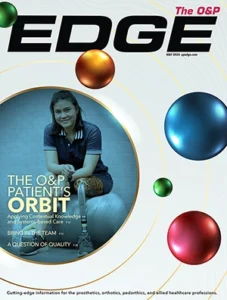Two Questions:
1. Should prosthetic offices charge patients and/or their insurance carriers
for their labor associated with repair or replacement of manufacturer’s
components that fail while on warranty?
2. Or should the manufacturer reimburse the prosthetic office for the labor
required to remove defective components that are still on the mfr’s warranty
as well as the labor to install interim loaner units, and the labor to then
reinstall repaired or replacement units?
Several of us prosthetists were attending a local VA clinic recently and were
discussing the onerous cost of doing repairs to a prosthesis when a component
that is still under a mfr.’s warranty fails. It was agreed that it is
usually not considered legitimate to bill the patient or his insurance carrier for
the labor associated with removing and replacing defective components that are
still covered on the manufacturer’s warranty. One prosthetist aptly pointed
out that if you bring your car into the auto dealership and a part is found to
have failed, the dealer replaces it if it is covered by the manufacturer’s
warrant–just like we do in the P & O profession. The difference is that the
dealer then charges the manufacturer for the technician’s time to perform the
necessary warranty repairs.
About nine months ago, I was carping on this LISTSERV about our difficulties
with defective Mauch SNS units after Ossur acquired Mauch, which resulted in
much frustration and inconvenience both to us and our patients. To wit, the
supplier that has currently earned my ire is Otto Bock who now owns TEC. We
have a number of patients on the TEC Harmony VASS system. Let it first be said
that the concept is ingenious and Carl Caspers deserves to be applauded for his
innovation. However, among a number of patients that we have on the system,
three of our relatively active patients have been plagued with problems with
the Harmony PRS pump.
The case of patient CS, who is a 40 yr. old, functional level K-3 transtibial
amputee and is 6’5″ 190#, illustrates my point. The patient experienced
problems with the integrated female pyramid on his Harmony pump axially rotating
in relation to the pump–which results in his prosthetic foot drifting
inadvertently into unwanted toe in/toe out. Needless to say, he experiences a sense
of uncertainty as to where his foot might be at any given step since the foot
doesn’t recenter itself as it would with a torque absorber. Clearly, this has
raised safety and liability issues. To address this problem, over the course
of a year, the patient has been in our office six times. Each time, TEC/Otto
Bock had supplied us with either a loaner or a new replacement pump. On two
occasions, the TEC loaner unit was found to be unreliable and failed as well.
Since July, the patient has had three successive new pumps supplied by Otto
Bock, each has proven to have the same rotation problem or leaked compressed air.
In addition to the problems with the pump, TEC has had further difficulties
fabricating this patient’s liners so that they are of consistent size and
thickness.
If one actually clocks the time necessary for a practitioner to evaluate the
problem that the patient is having, the time necessary for a tech to remove
the Harmony pump and install a loaner, then for the practitioner to verify that
the unit is functioning properly on the patient, both the practitioner and the
tech have easily spent an hour before the patient is on his way. Add to
that, the shipping/receiving as well as the bookkeeping time associated with
requesting and tracking return authorizations and UPS call tags, and the time spent
is enormous. Including the 21 phone calls, and 25 emails between our office
and TEC/Otto Bock as well as those to/from the patient related to these
issues, my practice has burned up 15 practitioner hours and 14.5 tech hours on
defective TEC/Otto Bock components still on warranty for this patient alone.
Using AOPA’s cost accounting method to identify our labor cost and overhead
associated with the 29.5 hours spent on the defective components on this patient, we
experienced a total unreimbursed cost of $4,722. In addition, just imagine
the cost to the patient of travel to our office as well as taking time off from
his upper management position with an Information Technology firm. Further,
recognize the risk of loosing credibility with a valued patient.
I won’t bore you with the details re. our two other patients with similar
stories other than to say that, in the course of nine months, one patient
experienced four pump failures and the other patient was inconvenienced with three
pump failures. In both cases, eight visits for each patient were required to
attempt to rectify the problem–all during the mfr’s warranty period. Suffice
it to say, we have sustained significant losses in the form of unreimbursed
labor because of the unreliable TEC/Otto Bock Harmony system components.
Why, you ask, would anyone doggedly continue to attempt to manage a patient
in such an unreliable system and not simply “cut bait”? The answer is simple.
All three patients are committed wearers of the Harmony VASS system. They
find the prosthetic suspension to be far superior to that of any other method.
Further, they appreciate the fact that, unlike other prosthetic socket
systems, their limb does not shrink appreciably during the course of the day while
wearing the VASS system. Thus, they have resigned themselves to put up with the
significant inconvenience and uncertainty of the unreliable pumps because in
their experience, when it’s working properly, the VASS socket can’t be beat
for comfort. How often have we all found ourselves caught holding the bag in
this fashion?
In fairness to Otto Bock and even TEC, both have fallen all over themselves
by promptly sending either a new replacement or a loaner unit. Further, any
representative at Otto Bock is quick to acknowledge that they “feel your pain.”
Moreover, Otto Bock inherited the problems with the Harmony PRS pump–but,
hey, their acquisition of TEC provided them access to the innovation as well as
the headaches. Clearly, Otto Bock has gotten a black eye over this one.
Although Otto Bock is beta testing a new unit that is expected to be free of the
problems found with the original Harmony PRS pump, we feel as though we have
been beta testing the original Harmony PRS pump all along even though it was a
production model on the market for which patients paid handsomely.
David Varnau, LPO, CPO
Center for Prosthetics Orthotics, Inc.
www.cpo.biz




